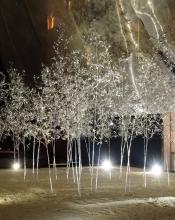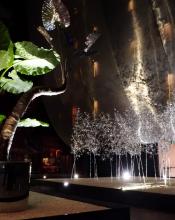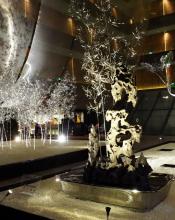Hidden Garden by Guo Zilong
Very few young Chinese artists can successfully combine their personal hope and spirit of enterprise with an Eastern view and sensibility about Nature, yet Guo Zilong has achieved this. In the perfection of each of his works we see a well-tempered beauty, yet this beauty conceals within it dangerous conflicts: between man and nature, between hope and seclusion, between self-awareness and the objective world. The state of the gleaming metal and the real trees feeds a double-edged conflict, structuring the works. The metal represents man’s ambition and self-assertion, while the latter represents nature itself, with its purity, tenderness, harmony and infinity of change. Through the combination of opposites, Guo Zilong acts as a medium creating a dialogue and fusion that give rise to a new reality. In his works, the contrast between metal and wood becomes fused, so that the viewer can sense an unexpected, yet unified, aesthetic.
As an artist who embraces Eastern culture, and as a person who finds his spiritual wellsprings in China’s ancient poetry and calligraphy, it is from what is called “the Nature of the Way” that Guo Zilong finds the source of his art and chooses the miniature garden, bamboo and green plants as his main elements. However, Guo Zilong is not an artist confined by tradition; it is through his bold use of metal and natural forms that have been polished, worked, grafted, and then repositioned that he is able to show his respect for nature and praise its achievements, its spirit of freedom, and its vitality. Plants removed from Nature can die, but the objective existence and vicissitudes of the artist’s creations bring new hope. In Guo Zilong’s works, we can truly attain understanding and insight regarding the dazzling beauty of life and the purity of nature, and of the infinite relationships that exist between them.
Guochen Zhao
Translated by Dr. Bruce Doar






